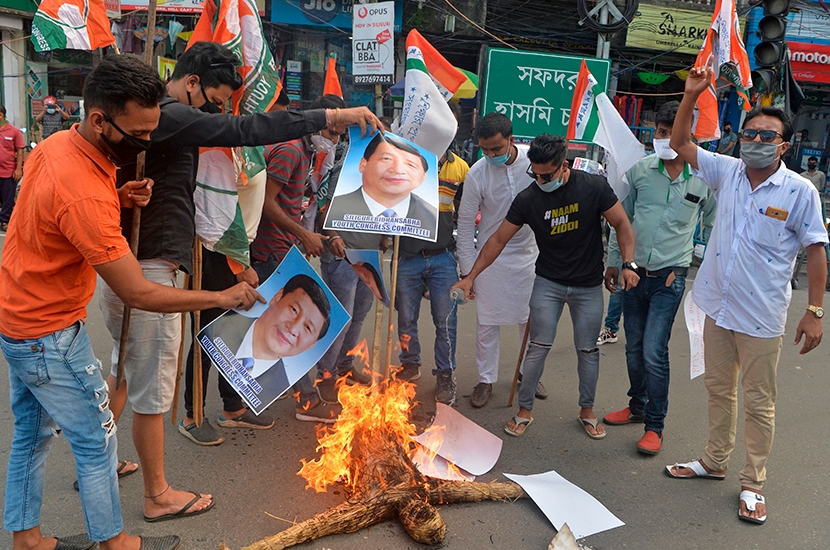When the Chinese Central Military Commission drew up plans for a ‘war of extermination’ which would ‘gnaw the flesh off the bones’ of Indian forces in the Himalayas in 1962, China’s leaders believed that they were solving a problem. ‘It was India,’ as vice minister Zhang Hanfu said to the Soviet ambassador at the time, ‘that rejected peace talks to solve the Sino-Indian border issue, while China consistently adhered to a peaceful solution.’
And so the China-India Border War began, with Chinese troops sweeping through the disputed Himalayan territories, driving Indian soldiers from their positions. To China’s Communist party, military victory meant that India and China would soon be friends. ‘Our conflict with India is one finger out of 10,’ argued Mao. ‘Nine fingers are friendship.’ India had to be ‘taught a lesson’ and China’s war, to the Communist party, was ‘rational, beneficial, [and] courteous’.
Ever since, troops from both countries have patrolled the mountains with only occasional skirmishes. Brawls, when they do come, normally involve fist fights or rock-throwing. It’s not yet clear how 20 Indian soldiers were killed by Chinese forces this time — reports suggested that clubs studded with nails were the lethal weapon — or how many Chinese soldiers have been killed in turn, but it’s the first deadly clash in decades. India has been stepping up construction of roads and infrastructure on its side of the border, and China’s leaders are ever more comfortable using coercive methods to intimidate neighbors large and small.
A People’s Liberation Army statement demonstrated the uncompromising mentality that now defines Xi Jinping’s foreign policy from the South China Sea to Hong Kong: ‘The sovereignty of the Galwan River Valley has always been ours,’ it said. ‘The Indian border troops went back on their word, seriously violating the agreements… We demand that India strictly restrain the front line troops, immediately stop all violations and provocations, and together return to the correct track of dialogue.’ Meanwhile, Communist party mouthpieces have spent recent weeks boasting of new military capabilities from Type 15 tanks, Z-20 helicopters, and G-20 drones ‘that should give China the advantage in high-altitude conflicts’.
Troops from both countries have been gathering, at a time of year when melting snow makes more of the territory accessible. There have been many talks and various warnings: Beijing has been unhappy to see India grow closer to the United States or take steps to build its own advantages in the contested border regions. Donald Trump’s recent offer to mediate for peace in the Himalayas has not been accepted. There have been standoffs before, the most serious lasting for a long summer in 2017 when Indian troops stopped the Chinese military from building a road at the trijuncture with Bhutan. But no one was killed. Both countries sent reinforcements; both backed down.
Every year, India counts the ‘transgressions’ of Chinese troops in the mountains: 273 of them in 2016, rising to 426 the year after then falling to 326. Things may have looked as if they were quietening down. But the killing of 20 Indian troops is a turning point — and unlikely to be the only instance of violence as a militarized China asserts itself upon its region and the world.
[special_offer]
With the use of the Chinese military against a neighbor for the first time in the 21st century, Xi Jinping is testing the limits not only of India, but of the world’s response to China’s rise to power. Other tests will follow. For example, how will Britain respond to China’s full annexation of Hong Kong and its defiance of the Sino-British Joint Declaration? Might the world be too mired in coronavirus woes to worry, much, about consequential foreign affairs?
Whether it is issuing threats to Britain over Huawei and critical infrastructure projects, punishing Australia through curtailed beef imports over calls for an inquiry into the origins of COVID-19 or sinking Vietnamese fishing trawlers in the South China Sea, China has made it clear to many nations that it is ready to push hard to have its way.
The question is whether the world is ready to push back. As politicians and business leaders ready themselves for any sort of commercial or diplomatic handshake with China’s regime, they must ask themselves just how many fingers on that extended hand are really made for friendship.


















